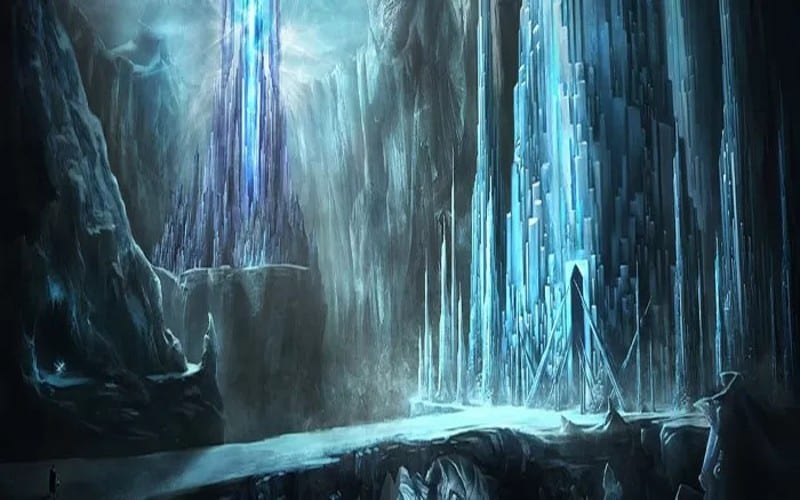Delving Deep: A Look at the Hollow Earth Theory
The idea of a hollow Earth, a planet with a vast subterranean cavity, has captured imaginations for centuries. It features in ancient myths and modern conspiracy theories, sparking curiosity and debate. But how much credence can we give this idea? Let's delve into the world of Hollow Earth theories, exploring their origins, variations, and the scientific evidence that counters them.
A History of Hollow Earth
The concept of a hollow Earth stretches back to ancient civilizations. Norse mythology mentions a realm called Niflheim, a land of ice and mist located beneath the Earth. Similarly, some Hindu beliefs speak of a subterranean world called Patala. In the 17th century, Edmond Halley, the famed astronomer, proposed a hollow Earth with concentric shells. He even theorized about openings at the poles, a common theme that persists in some modern versions.
Niflheim
John Cleves Symmes, an American captain in the early 1800s, became a prominent advocate for the hollow Earth theory. He envisioned a vast, habitable inner Earth accessible through polar openings. Symmes even petitioned the U.S. Congress to fund an expedition to explore these openings. While his ideas were never taken seriously by the scientific community, they captured the public imagination.
John Cleves Symmes
Variations on a Hollow Theme
The modern Hollow Earth theory encompasses a spectrum of ideas. Some proponents believe in a hollow Earth with a solid inner core, often depicted as a sun providing light for a subterranean civilization. Others envision a completely hollow Earth, with the sun, moon, and stars projected onto the inner surface by an unknown mechanism. Flat-Earthers sometimes incorporate a hollow Earth into their belief system, with the Earth being a dome-shaped world with a hollow interior.
Arguments for a Hollow Earth
Proponents of the Hollow Earth theory often cite various phenomena as evidence. Some point to unexplained sightings of anomalous objects in the sky, suggesting they originate from the inner Earth. Another argument revolves around the idea that gravity wouldn't exist on a hollow Earth. However, this misunderstands gravity, which is a function of mass, not solidity. A hollow Earth with sufficient mass would still exert gravity.
The unusual behavior of compasses near the poles is also sometimes used as "proof." However, this can be explained by the complex magnetic field of the Earth and wouldn't necessarily indicate a hollow interior. Additionally, some proponents cite the supposed lack of evidence for a molten core. However, extensive scientific research using seismic waves has provided strong evidence for a liquid outer core and a solid inner core.
Why Science Rejects the Hollow Earth
The idea of a hollow Earth simply doesn't align with our current scientific understanding of the planet. Here's why:
- Gravity: The Earth's gravity is a function of its mass being concentrated towards the center. A hollow Earth wouldn't have the same gravitational pull we experience.

- Seismic Waves: Earthquakes generate seismic waves that travel through the Earth's interior. The way these waves travel tells us about the composition of the Earth, and the data clearly indicates a solid, differentiated interior with a liquid outer core.

- Space Exploration: We have sent probes deep into space and directly observed the Earth from afar. These observations confirm that the Earth is a sphere, not hollow.

The Allure of the Hollow Earth
Despite the lack of scientific evidence, the Hollow Earth theory persists for a few reasons. Firstly, the idea taps into a sense of wonder and mystery. The thought of a hidden world within our own planet is undeniably captivating. Secondly, the theory can be adapted to explain away inconsistencies or gaps in understanding, offering a seemingly simple solution to complex phenomena.
Conclusion: A Hollow Dream
The Hollow Earth theory, while intriguing, is ultimately incompatible with our scientific understanding of the planet. The weight of evidence, from gravity and seismic waves to space exploration, overwhelmingly points towards a solid Earth with a differentiated interior. Yet, the concept continues to hold a certain allure, a testament to the human fascination with the unknown. While the idea of a subterranean world may spark our imagination, true scientific discovery lies in unraveling the real mysteries of our planet, a process that continues with every new exploration and scientific advancement.






















































